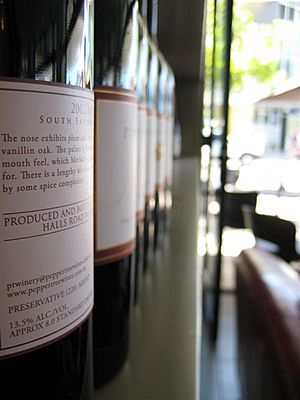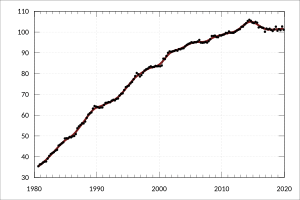Australian wine facts for kids
The Australian wine industry is a big part of Australia's economy. It's the world's fifth largest exporter of wine! This means Australia sends about 780 million litres of wine to other countries each year. Only about 40% of the wine made in Australia is actually enjoyed by people living there.
Australians buy over $2.8 billion worth of Australian wines every year. They drink more than 530 million litres annually. Most of this is white wine (50%), followed by red wine (35%).
Wine is made in every state of Australia. There are over 60 special wine regions, covering about 160,000 hectares of land. Most of these regions are in the cooler, southern parts of the country. You'll find vineyards in South Australia, New South Wales, Victoria, Western Australia, Tasmania, and Queensland. Each region grows different types of grapes and makes different styles of wine. This is because of the unique Terroir (the natural environment, including climate, land features, and soil types).
The main types of grapes grown are Shiraz, Cabernet Sauvignon, Chardonnay, Merlot, Semillon, Pinot noir, Riesling, and Sauvignon blanc. When you see a wine label with a grape name, it means at least 85% of the wine is made from that grape.
Contents
History of Australian Wine
The first grapevines arrived in Australia with the First Fleet in 1788. Governor Phillip brought them from the Cape of Good Hope to the penal colony of New South Wales. The first try at making wine didn't work out. But other settlers kept trying and eventually succeeded. By the 1820s, Australian-made wine was being sold.
In 1822, Gregory Blaxland was the first person to send Australian wine overseas. He also won the first international award for Australian wine. Vineyards were set up in the Hunter Valley in 1830. In 1833, James Busby brought back many different grape varieties from France and Spain. These included classic French grapes and grapes for making fortified wines.
In 1844, wine from the Adelaide Hills was sent to Queen Victoria. The quality of Australian wine got much better when free settlers from Europe arrived. They used their skills to create some of Australia's best wine regions. For example, people from Prussia helped establish the Barossa Valley in South Australia in the mid-1850s. Winemakers from Switzerland also helped start the Geelong wine region in Victoria in 1842.
Early Australian winemakers faced challenges because the climate was new to them. But Australia's warm, dry, Mediterranean climate turned out to be great for growing grapes. Australian wines started winning big awards in French competitions. At the 1873 Vienna Exhibition, French judges praised some wines from Victoria. They were surprised when they found out the wines were Australian! An Australian Syrah wine at the 1878 Paris Exhibition was even compared to a famous French wine, Château Margaux.
Australia has quickly become a world leader in both the amount and quality of wine it produces. For example, Australia sent 20 million cases of wine to the US in 2004, up from 578,000 cases in 1990. In 2000, Australia exported more wine to the UK than France did for the first time.
Sometimes, the industry has made too much wine. In the late 1980s, the government even paid growers to remove their grapevines to reduce the extra supply.
In recent years, organic and biodynamic wines have become more popular. These wines are made using natural farming methods. In 2004, Australia hosted the first international meeting for biodynamic wine producers.
Grape Varieties
The main types of grapes grown in Australia are Shiraz, Cabernet Sauvignon, Merlot, Chardonnay, Sauvignon blanc, Sémillon, and Riesling. Australia doesn't have any native grapes. All the grape varieties, like Vitis vinifera, were brought from Europe and South Africa in the late 1700s and early 1800s. Some new varieties, like Cienna and Tarrango, have been created by Australian grape growers.
Shiraz was originally called Syrah in other parts of the world. But because of its huge success in Australia, many Syrah producers globally now label their wine "Shiraz."
About 130 different grape varieties are used by Australian winemakers. Recently, many winemakers have started trying "alternative varieties." These include grapes from France, Italy, and Spain, such as Petit Verdot, Pinot grigio, Pinot noir, Sangiovese, Tempranillo, and Viognier.
Australian winemaking has been very successful. It has set high standards for wines like Chardonnay and Shiraz. Australians have also come up with new ways to manage vineyards and make wine. Australian winemakers often travel the world, working in other countries during their off-season. They are very important in sharing wine knowledge globally.
GSM Blends
GSM is a common name for a red wine that mixes three grapes: Grenache, Shiraz, and Mourvèdre. If Shiraz is the main grape, it's sometimes called SGM.
This blend started in the Southern Rhône region of France. It's also popular in South Australia, California, and Washington.
- Grenache is the lightest of the three grapes. It makes a pale red wine with soft berry smells and a little spice. It adds alcohol and fruitiness without making the wine too strong.
- Shiraz adds rich, fruity flavours like black fruits and pepper. It gives the wine its colour, structure, and strength.
- Mourvèdre adds elegance and a good structure to the blend. It can have flavours of sweet plums and hints of tobacco.
Wine Production
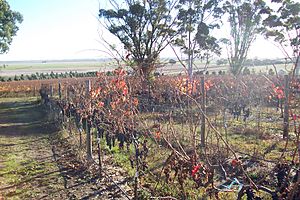
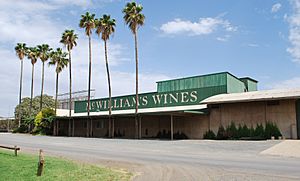
Australia's most famous wine is Penfolds Grange. The 1955 vintage (year it was made) of this wine won more than 50 gold medals since 1962. The 1971 vintage won first prize at the Wine Olympics in Paris. The 1990 vintage was named 'Red Wine of the Year' by Wine Spectator magazine in 1995. Some experts even call Grange the best wine from the Southern Hemisphere.
Other red wines that are well-known internationally include Henschke Hill of Grace, Clarendon Hills Astralis, D'Arenberg Dead Arm, and Torbreck Run Rig.
Australia has almost 2000 wine producers. Most of these are small wineries. However, a few big wine companies control most of the market. The largest wineries are Casella winery in Yenda, NSW (which makes YellowTail wines) and Berri Estates winery in Glossop, SA. Most of the grapes are grown in the dry Murray-Darling basin region.
Major Wine Regions
The information on wine labels is very strict. Labels must not say anything false about where the grapes came from. Many names for wine regions are protected. These are divided into "South Eastern Australia," state names, zones, regions, and subregions.
Most wine is made from grapes grown in the warm Murray-Darling Basin zones. However, the more expensive, high-quality wines often come from smaller, cooler regions.
The South Australian wine industry makes most of Australia's wine. In recent years, the Tasmanian wine industry has become known for high-quality wines. The Tamar Valley in Tasmania is famous for its Chardonnay and Pinot noir, which grow well in the cooler climate. Queensland is also developing its wine industry, with over 100 vineyards. Some notable wines are made in the high-altitude Granite Belt region, near the towns of Stanthorpe and Ballandean.
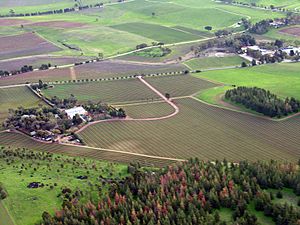
Some well-known wine-producing regions include:
- Adelaide Hills
- Barossa Valley
- Clare Valley
- Coonawarra
- Eden Valley
- Langhorne Creek
- McLaren Vale
- Padthaway
- Riverland
- Southern Fleurieu
- Wrattonbully
- Alpine Valleys
- Beechworth
- Goulburn Valley
- Grampians
- Heathcote wine region
- Henty
- Mornington Peninsula
- Pyrenees
- Rutherglen
- Strathbogie Wine Region
- Yarra Valley
- King Valley
- Bendigo
- Glenrowan wine region
- Hunter Valley
- Mudgee
- Orange
- Riverina
- New England
- Southern Highlands
- Shoalhaven Coast
Greater Perth:
- Perth Hills
- Peel
- Swan Valley
South Western Australia:
- Blackwood Valley
- Geographe
- Manjimup
- Margaret River
- Pemberton
- Great Southern:
-
- Albany
- Denmark
- Frankland River
- Mount Barker
- Porongurup
- Tamar Valley
- Derwent Valley
- Huon Valley / Channel
- Coal River
- Pipers River
- East Coast
- North West
Images for kids
See also
 In Spanish: Vino de Australia para niños
In Spanish: Vino de Australia para niños


